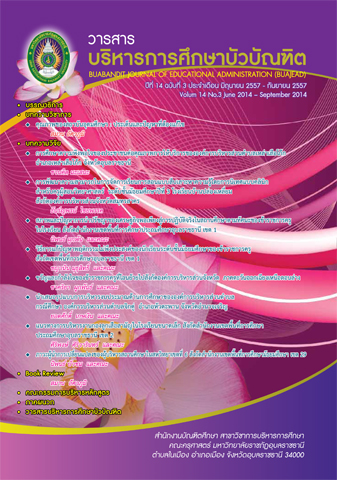รูปแบบการบริหารงบประมาณด้านการศึกษาขององค์การบริหารส่วนตำบล กรณีศึกษาองค์การบริหารส่วนตำบลจิกดู่ อำเภอหัวตะพาน จังหวัดอำนาจเจริญ
Main Article Content
บทคัดย่อ
การวิจัยในครั้งนี้มีวัตถุประสงค์เพื่อศึกษารูปแบบการบริหารงานงบประมาณด้านการศึกษ ขององค์การบริหารส่วนตำบล กรณีศึกษา องค์การบริหารส่วนตำบลจิกดู่ อำเภอหัวตะพาน จังหวัดอำนาจเจริญ เพื่อร่างรูปแบบการบริหาร งานงบประมาณด้านการศึกษาขององค์การบริหารส่วนตำบล เพื่อนำเสนอรูปแบบการบริหารงาน งบประมาณด้านการศึกษาขององค์การบริหารส่วนตำบล
กลุ่มตัวอย่างจำนวน 34 คน ได้แก่ คณะผู้บริหารองค์การบริหารส่วนตำบลจิกดู่ จำนวน 6 คน สมาชิกสภาองค์การบริหาร ส่วนตำบลจิกดู่ จำนวน 12 คน หัวหน้าสำนัก หัวหน้าส่วน ได้แก่ ปลัดองค์การบริหารส่วนตำบล หัวหน้าส่วนการคลัง หัวหน้าส่วนการศึกษา ศาสนาและวัฒนธรรม รวมจำนวน 3 คน ข้าราชการ ส่วนท้องถิ่น จำนวน 9 คน หัวหน้า ศูนย์พัฒนา เด็กเล็กสังกัดองค์การบริหารส่วนตำบลจิกดู่ จำนวน 4 คน เครื่องมือที่ใช้ ได้แก่ แบบสัมภาษณ์ แบบบันทึกการประชุม แบบบันทึกการสนทนากลุ่มแบบประเมินค่าความเหมาะสม และความเป็นไปได้ของรูปแบบ สถิติที่ใช้ ได้แก่ ค่าเฉลี่ย ส่วนเบี่ยงเบนมาตรฐาน และการ วิเคราะห์เนื้อหา
ผลการวิจัยพบว่า
1. รูปแบบการบริหารงานงบประมาณด้านการศึกษาขององค์การบริหารส่วนตำบล กรณีศึกษา องค์การบริหารส่วนตำบล จิกดู่ อำเภอหัวตะพาน จังหวัดอำนาจเจริญ ประกอบด้วย 4 ด้าน คือ 1) ด้านการจัดทำงบประมาณ ประกอบด้วย การสำรวจข้อมูล การวางแผน การพิจารณางบประมาณ 2) การอนุมัติ งบประมาณ 3) การบริหารงบประมาณ ประกอบด้วยการเบิกจ่ายงบประมาณ การจัดระบบการจัดซื้อจัดจ้าง การดำเนินการ/การบริหารโครงการการควบคุมงบประมาณการ รายงานการเบิกจ่ายงบประมาณ 4) การตรวจสอบ ประกอบด้วยการตรวจสอบภายในและ การตรวจสอบภายนอก
2. การร่างรูปแบบการบริหารงานงบประมาณด้านการศึกษาขององค์การบริหารส่วนตำบล ประกอบด้วย 4 ด้าน คือ 1) ด้านการจัดทำงบประมาณ ประกอบด้วยการสำรวจข้อมูล/ศึกษาความเป็นไปได้ของ โครงการหรือกิจกรรมที่จะดำเนินการการวางแผน การพิจารณางบประมาณ ได้แก่ เงินสะสม งานวิชาการ งานบริหารงานบุคคล งานบริหาร การศึกษาทั่วไป 2) การอนุมัติงบประมาณ 3) การบริหารงบประมาณ ประกอบด้วยการ เบิกจ่ายงบประมาณ การจัดระบบการจัดซื้อจัดจ้าง การดำเนินการ/การบริหารโครงการการควบคุมงบประมาณ การรายงานการเบิกจ่ายงบประมาณ 4) การตรวจสอบ ประกอบด้วยการตรวจสอบภายใน และการตรวจสอบภายนอก
3. การประเมินความเป็นไปได้และความเหมาะสมของร่างรูปแบบการบริหารงาน งบประมาณด้านการศึกษาขององค์การบริหาร ส่วนตำบล คือ 1) ความเป็นไปได้ของรูปแบบ การบริหารงบประมาณด้านการศึกษาขององค์การบริหารส่วนตำบล แบ่งออกเป็น 4 ด้าน คือ ด้านการจัดทำงบประมาณอยู่ในระดับมาก ( = 4.20) ด้านการอนุมัติงบประมาณอยู่ในระดับมาก (
= 4.45) ด้านการบริหารงบประมาณอยู่ในระดับมาก (
= 4.07) และด้านการตรวจสอบอยู่ในระดับมาก (
= 3.95) สรุปความเป็นไปได้ ของรูปแบบการบริหารงบประมาณด้านการศึกษา ขององค์การบริหารส่วนตำบล ทั้ง 4 ด้าน มีระดับความเป็นไปได้มาก 2) ความเหมาะสมของรูปแบบการบริหารงบประมาณด้านการศึกษาขององค์การบริหารส่วนตำบล แบ่งออกเป็น 4 ด้าน คือ ด้านการจัดทำงบประมาณอยู่ในระดับมาก (
= 4.36) ด้านการอนุมัติงบประมาณอยู่ในระดับมาก (
= 4.40) ด้านการบริหารงบประมาณอยู่ในระดับมาก (
= 4.19) และด้านการตรวจสอบอยู่ในระดับมาก (
= 4.17) สรุปความเหมาะสมของรูปแบบการบริหารงบประมาณด้านการศึกษาขององค์การบริหารส่วนตำบล ทั้ง 4 ด้านมีระดับความเป็นไปได้มาก
4. การนำเสนอรูปแบบการบริหาร งานงบประมาณด้านการศึกษาขององค์การบริหารส่วนตำบล ประกอบด้วย 4 ด้าน คือ 1) ด้านการจัดทำงบประมาณ คือ การสำรวจข้อมูล/ศึกษาความเป็นไปได้ของโครงการ หรือกิจกรรมที่จะดำเนินการการวางแผน ได้แก่ การเสนอโครงการ การจัดทำแผน การอนุมัติแผน การพิจารณางบประมาณ ได้แก่ เงินสะสม งานวิชาการ งานบริหารงานบุคคล งานบริหารการศึกษาทั่วไป 2) การอนุมัติ งบประมาณ 3) การบริหารงบประมาณ คือ การเบิกจ่ายงบประมาณการจัดระบบการจัดซื้อจัดจ้าง การดำเนินการ/การบริหารโครงการการควบคุมงบประมาณการรายงานการเบิกจ่ายงบประมาณ 4) การตรวจสอบ จะต้องมีการตรวจสอบภายใน และการตรวจสอบภายนอก
The Proposition of Educational Administrative Budget Model of Sub-District Administration Office: A Case Study of Jikdu Sub-District Administration Office, Hua Tapan District of Amnat Charoen Province
The objectives of this study were to investigate the educational administrative budget model of Jikdu Sub-District Administration Office in Hua Tapan district of Amnat Charoen province, to create and to propose the model for administering educational budget.
A total of 34 samples including 6 Jikdu Sub-District administrators, 12 Jikdu Sub-District council members, 3 officers that is a head of administrative office, a head of finance, and a head of educational, religious, and cultural section, 9 local officers, and 4 heads of child development centers. The research instruments included interview, meeting record form, focus-group discussion form, and suitability and possibility assessment form. The collected data were analyzed by using the statistics namely mean, standard, and content analysis.
The research findings were as follows:
1. The result of the investigation of the model for administering educational budget showed four components of the model that is 1) budgeting containing information survey, planning, and considering budget expenses; 2) approving budget plan; 3) administering budget including budget spending, purchase and hiring system, project operation, budget control, and budget spending report; and 4) monitoring budget consisting of internal and external follow-ups.
2. The examination of model creation resulted in four aspects of budget administration 1) budgeting involving information survey/feasibility study of projects or activities, planning, providing budget for certain sections that is collective money, academic, personnel, and general education; 2) approving budget plan; 3) administering budget including budget spending, purchase and hiring system, project operation, budget control, and budget spending report; and 4) monitoring budget consisting of internal and external follow-ups.
3. The possibility and suitability of the model resulted in the level of possibility and suitability as follows: 1) the possibility in 4 aspects: budgeting at a high level (μ = 4.20), approving budget at a high level (μ = 4.45), administering budget at a high level (μ = 4.07), and follow-ups at a high level (μ = 3.95); the results indicated that the possibility of the model was at a high level; 2) the suitability of 4 aspect of the model including 1) budgeting at a high level (μ = 4.36), approving budget at a high level (μ = 4.40), administering budget at a high level (μ = 4.19), and follow-ups at a high level (μ = 4.17); the results indicated that the suitability of the model was at a high level.
4. The proposition of the model contained 4 aspects as follows : 1) budgeting involving information survey/feasibility study of projects or activities, planning, providing budget for certain sections that is collective money, academic, personnel, and general education; 2) approving budget plan; 3) administering budget including budget spending, purchase and hiring system, project operation, budget control, and budget spending report; and 4) monitoring budget consisting of internal and external follow-ups.

